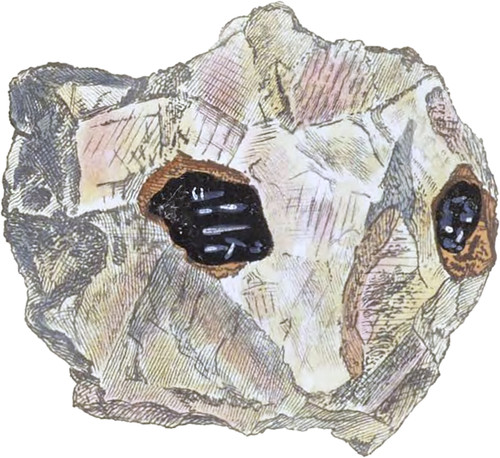 Enlarge
Enlarge
Exotic Mineralogy
Gadolinite
- Syn. Gadolinite. Haüy. 3. 141. Tabl. Comp. 47. Thomps. 4. 372. Sowerby’s Catalogue, pt. I. p. 72.
Gadolinite was discovered by Captain Arhenius, in light feldspar, at Ytterby in Sweden. Gadolin’s name was given to it, because he first ascertained its composition, and found it to contain a new earth, which is called Yttria, after the place wlience the specimens were obtained. This seems to give it a peculiar character, and is chiefly combined with a dark oxide of iron and silex. It is rarely found crystallized, but rather in small shapeless masses. The greatest part is very black, surrounded by an ochrey crust. It has a sharpish glossy fracture, a vitreous lustre, is too hard to be scratched by quartz, is brittle, opaque, and attracts the magnetized needle.
Whether this is likely to be found in Great Britain, is sufficiently doubtful to place it here; yet, as the substances in which it is found occur, it is not impossible. May not some new combination take place, even in the decomposition of magnetic iron-stone, and thus this substance succeed, as its outside seems to betray something varying. Spec. Grav. 4.0497.
| Ekeberg. | Vauquelin. | Klaproth. | |
|---|---|---|---|
| Yttria | 47.5 | 35.0 | 59.75 |
| Silica | 25.0 | 25.5 | 21.5 |
| Oxide of Iron | 18.0 | 25.0 | 18. 0 |
| Alumine | 4.5 | — | 0.50 |
| Oxide of Manganese | — | 2.0 | — |
| Lime | — | 2.0 | — |
| Water | — | 10.5 | — |
| Loss | 5.0 | — | 0.50 |
| 100.0 | 100.0 | 100.00 | |
The nearest approach to crystallization I have met with, is shown on the right hand of the figure, and approaches a rhomboidal prism. I have taken the liberty in the figure, to attach this fragment to the specimen which was lent me by Dr. E. D. Clarke.

